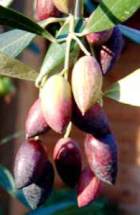
Plant Part: Fruit
Extraction: Cold Pressed
Growing Practice: Ethical
Country of Origin: Italy
An excellent fixed oil for all topical applications and as a carrier for essential oils.
Refractive Index: 1.4657 - 1.4707 @ 25° C.
Specific Gravity: 0.9150 to 0.9180 @ 20 °C
Appearance: dark-greenish yellow
liquid
BioChemicals: Saturated Fatty Acids (typically 7.5-20%): Palmitic 7.5-20%, Stearic 0.5-5.0%, Arachidic <0.8%, Behenic <0.3%, Myristic <0.1%, Lignoceric <1.0%
Monusaturated fatty acids (typically 55-83%): C18:1 oleic 55-83%, Palmitoleic 0.3-3.5%
Polyunsaturated fatty acids (typically 18%): C18:2 linoleic 3.5-21%, C18:3 α-linolenic <1.5%
May also contain squalene (<0.7%) and sterols.
Melting Point °C: -6.0 °C (21 °F)
Saponification Value: 184-196
CAS No: 8001-25-0
According to FAO, Olive is the most extensively cultivated fruit crop in the world, with 8.5 million hectares (21 million acres) in cultivation in 2003, producing over 17 million tons of olive fruit. The major producers are Spain, Italy, and Greece. Greece produces about 350,000 tons of oil annually. The oil yield is 18-20%.
The traditional method of oil extraction (used for over 5,000 years) is by the olive press. The olives are first ground into a paste using millstones. The ground paste is spread onto fiber disks and placed into the press. Hydraulic pressure up to 400 atmospheres is applied to the press, forcing the oil out of the paste. Water is used to wash it away. Since the oil and water don't mix, they are separated by decantation, or by a centrifuge. The oil so produced is considered to be Virgin oil, or Extra Virgin and is the best for skin care and cosmetic use, as well as for culinary and other uses. In the EU, if the maximum temperature reached during production was under 80 °F the oil may be designated first cold pressed or cold extraction. However, this regulation does not apply outside the EU, so claims from other parts of the world may not be truthful.
Modern methods of extraction have been developed using decanter centrifugation.
The pomace (material left over after the oil is separated) is sometimes subjected to further extraction using solvents, which produces a lower quality oil.
Therapeutic Properties for External Use
- calming, demulcent and emollient
- Good for burns,skin itching, and insect bites
- sprains and bruises
- weakly astringent
- weakly antiseptic
Cosmetic uses
- used in soaps, shampoos, hair coloring, face powders, lipsticks, emollients, anti-wrinkle oils, brilliantines, and eyelash oils.
- beneficial to dry skin
Olive oil is also used as a base for infused oils of various herbs.![]()
However, Price provides a cautionary note about olive oil adulterated with other oils such as cottonseed oil, and suggests that olive oil makes dandruff worse if applied to a dry scalp; and there is evidence of allergic reactions and sensitization if applied topically.
Olive oil is cited by RTECS as a skin irritant and for mutagenic effects in fruit fly studies.
The information provided on these pages is not a substitute for necessary medical care, nor intended as medical advice. Always keep carriers and bases tightly closed and in a cool, dark place, out of reach of children. If redness or irritation occurs when applied to the skin, stop using immediately and contact your health provider if necessary.![]()
all images and content copyright ©2000—2020 by suzumebachi design and samara botane





